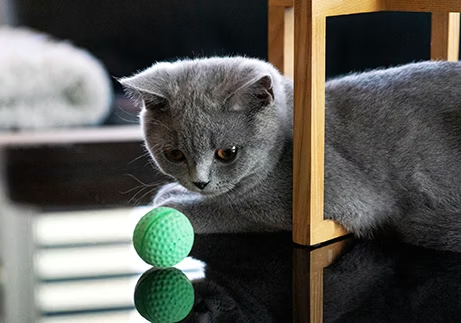Cats have a reputation for being independent and strong-willed. But just because they may not seem as eager to please as dogs, they are intelligent pets capable of learning behavioral cues and tricks. If you’d like to train your cat, use the steps below. And be aware—while the methods are simple, they must be paired with patience and consistency to succeed.
Training steps
1. Build trust
The earlier you start training your kitten or cat, the better. Still, before you begin training sessions, it’s important to establish a respectful, trusting relationship. If your cat is new to you, take time to get to know one another and bond. Cats usually need time to become comfortable with new people and surroundings. So take things slow and use opportunities like mealtime, playtime, and cuddle time to show your cat that you are there to love and care for them.
2. Use the proper tools (and motivation)
Clicker training is often associated with dogs, but it works well for cats, too! The purpose of a plastic clicker is to mark and reward desired behaviors. Take your cat to a quiet room with a clicker and some tasty treats to get started. Do a click, and then immediately give your cat a treat. Repeat this pattern, and soon your cat will begin to associate the clicker’s sound with treats.
And about those treats. You might get lucky and have a cat that will be happy with a piece of their regular kibble as a reward. But for greater success, consider a high-value treat that they don’t always get, such as canned tuna or cooked chicken. Here a little bit goes a long way, both in terms of not disrupting your cat’s diet and making sure they doesn’t become full too quickly.
3. Reward the behaviors your want
Once your cat has made the connection between clicks and rewards, you can use the clicker to mark desired behaviors as they happen. For example, if you want to train your cat to sit, click and reward when you see them sit on their own. Timing is important, so be sure to click the moment their bottom touches the floor. Then, incorporate a verbal cue (like saying "sit") when you see them start to sit down, followed by a click when they perform the behavior and an immediate reward. Your cat will learn that sitting after hearing the verbal cue means they get a treat. And just like that, your cat is on their way to mastering their first trick!
4. Praise, don’t punish
Cats don’t respond well to discipline or punishments. In fact, a punitive approach to training can stress out your cat, putting any progress you’ve made at risk. Instead, focus on positive reinforcement. When your kitty does something right, let them know with praise or treats. When they are doing something wrong, gently distract them and try to turn their attention to more appropriate behaviors.
5. Practice makes purrfect
Consistent training produces consistent results. The more you practice a particular cue or trick, the more likely your cat is to perform the desired behavior reliably. However, don’t plan on any marathon training sessions. Instead, keep sessions to a few minutes, and do them several times a day. And focus on learning one behavior at a time, so your cat doesn’t get overwhelmed or confused.
Each cat is unique, so don’t be discouraged if it takes time for your feline friend to come around to clicker training. You can also try different methods of motivation. For example, you can swap the type of treat, use a favorite toy, or provide praise for those highly affectionate kitties.

Tips for teaching common commands
Come. To train your cat to come, you’ll want to lure them with a favorite toy or snack. When standing across the room, give the "come" signal while shaking a bag of treats or waving their wand toy. When they come to you, click and treat (and let them play with the toy). Once they consistently come when showing them something they want, work on giving the cue without the enticement.
High five. Start by teaching your cat to fist bump. Hold a treat in a closed fist near the ground. When your cat paws at your hand to get to the treat, click and reward. Over time, move your fist higher and higher off the ground while giving a verbal cue. When your cat consistently paws at your closed fist when held at a high five height, practice the command with an open hand and no treat.
Fetch. Who says fetching is just for dogs? You can teach your cat to fetch by breaking the behavior into steps and rewarding them as they master each component. Start by choosing a small toy or ball and holding it near your cat’s face. Click and reward every time they sniff or paw at the toy. Then place the toy on the ground and click and reward when they pick it up in their mouth. Next, toss the toy a few feet away, and click and reward when your cat goes to the toy and picks it up. By adding steps one at a time—and marking the desired behaviors along the way—your cat will be able to master more complex tricks.
These are just a few behaviors you can train your cat to perform. Using these same techniques and principles, you can teach your cat to stand, stay, roll over, or even use a toilet!



